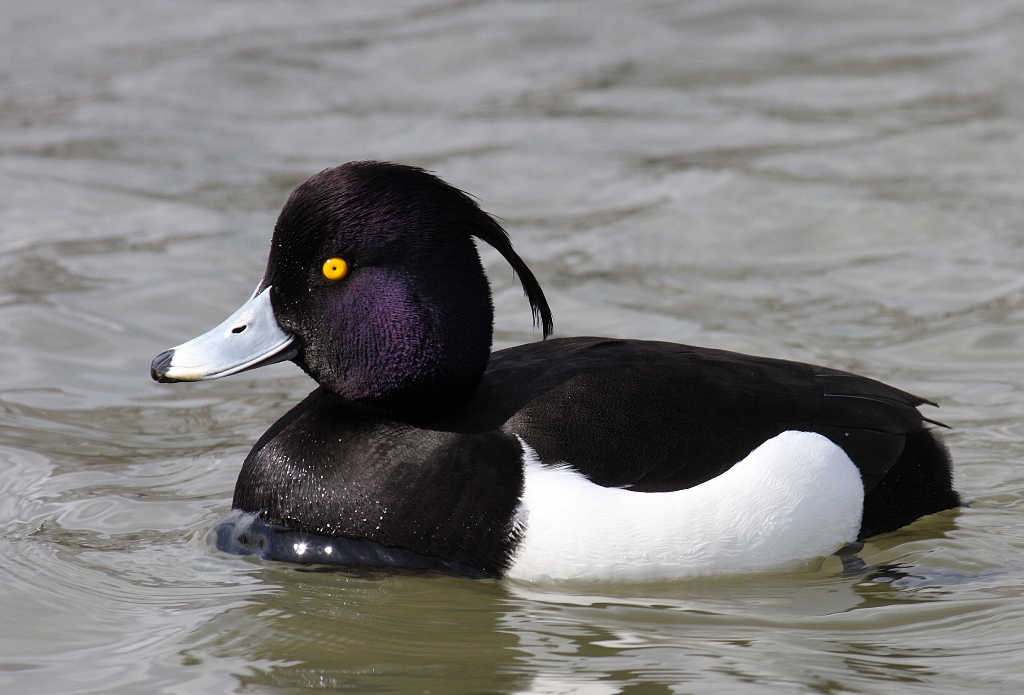
Tufted duck(Aythya fuligula)
Phylum —chordata
Class — aves
Order — anseriformes
Family — anatidae
Genus –aythya
Appearance
Tufted ducks are small to medium-sized diving ducks. Sexual dimorphism is clearly apparent among males and females. Males are typically larger than females, with an average body length of 42 to 48 cm and a mass of 753.0 to 1026.2 g. Females generally range from 39 to 44 cm in length and weigh in at 629.8 to 906.8 g. Seasonally, body mass will fluctuate between sexes. Both male and female tufted ducks have an average wingspan of 70 cm.
The adult male is all black except for white flanks and a blue-grey bill with gold-yellow eyes, along with a thin crest on the back of its head. It has an obvious head tuft that gives the species its name. The adult female is brown with paler flanks, and is more easily confused with other diving ducks.
Habitat
Tufted ducks are migratory birds with a broad geographic range that extends from Eurasia and Africa to the North American coasts.
During breeding months (May to early August), tufted ducks inhabit most Palearctic regions such as the Faroe Islands, the British Isles, Norway, nearly all of Europe, and Asia to eastern Siberia. During the winter months (November to April), tufted ducks can be found in southern Europe, northern Africa, southern Asia, and some areas throughout North America. They can also be found occasionally throughout areas of Madeira, Borneo, Liberia, the Seychelles, Pelew, Marianne and Philippine Islands.
Behavior
Tufted ducks are migratory birds that travel seasonally between the breeding and overwintering grounds. Like most ducks, they are highly aquatic and rarely stray far from a body of water. They are diurnal for most of their life but may migrate nocturnally.
During the breeding season, male tufted ducks establish territories surrounding their nest and will defend it against neighboring males and predators. During migratory periods and the non-breeding season, they are social. Groups typically gather in shallow lakes, ponds, and slow moving rivers.
This species can be distinguished from other diving ducks by their unique diving behavior. They launch themselves slightly out of the water to help submerge their bodies underwater while foraging in shallow water. Submergence time for juveniles is less than that of adults.
Diet
These birds eat mollusks, aquatic insects and some plants.
Reproduction
The pair forms during late winter and spring migration. Some courtship displays can be observed with both male and female swimming together while dipping their bills in and out of the water. Another display shows the males swimming quickly past female, stretching their neck out to its entire length and holding it for a few seconds. The male also swims fast while nodding the head back and forth or preening behind the wing. Copulation occurs in the water. They are monogamous for the season.
The breeding season starts in May. The tufted duck nests in single pairs or loose groups, usually with nests 7-11 meters apart. They nest near water, about 20 meters from the water, often among dense vegetation. When nesting on islands, the nest is sometimes up to 150 meters from the water. They may nest sometimes within gull colonies, with nests much closer to each other.
The female builds the nest on the ground, making a support with grasses and feathers, before to build the bowl-shaped structure with grass and sedges. She adds a lining of down and vegetation.
The female lays 8-10 olive-grey eggs and incubates alone during 26-28 days. During the incubation, the males form moulting flocks.
At hatching, the chicks have sooty-brown down above and pale yellowish down below. They fledge about 45-50 days after hatching. The female rears the chicks and leaves them after 30-40 days. The tufted duck produces a single brood per season.
In captivity
In captivity, these birds can live up to 20 years, in nature, the lifeexpectancyis much less.
These birds need a deep pool, but the best option is a reservoir (pond).
The diet of these birds should include various kinds of leaves, water lilies, wild celery, wild rice, millet. It should also containmollusks, snails, nymphs, earthworms and leeches. Protein-rich food is important for birds during the reproduction season. During feeding, adult females eat almost only organic food.
 Russian
Russian
 English
English
























